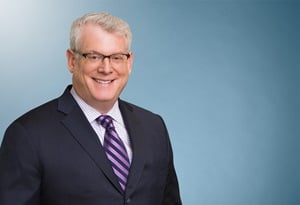COVID-19 Case Studies: Supply Chain Leadership Solutions for Pandemic Preparedness
As part of our recent Health Care Amid and After COVID-19 webinar series, Faegre Drinker Partner Neil Olderman spoke to Brendan Schepis of Stamford Health and Suzzanne Thomson Quintero of Orlando Health to discuss each system’s COVID-19 experience and how institutions can change their supply chain operations to avoid future disruption of personal protective equipment (PPE) and other key supplies.
Brendan Schepis is the executive director of supply chain at Stamford Health. Stamford Health operates one, 300-bed hospital and serves Fairfield County in Connecticut. Considering Stamford Health’s proximity to New York City and West Chester County, New York, in the initial surge of COVID-19 cases, Fairfield County was a hot zone. At peak census, Stamford Health treated 150 patients with confirmed COVID-19. By June 2020, Stamford Health had 601 COVID-19 patient admissions.
Suzzanne Thomson Quintero is vice president and chief supply chain officer at Orlando Health. Orlando Health is located in central Florida and spans nine counties, including Orange County, home of Disney and Universal theme parks. Orlando Health operates nine hospitals, serving a capacity of 3,300 beds.
Experience and Action
Stamford Health
Before the first COVID-19 patient arrived at Stamford Hospital on March 11, 2020, Stamford Health had increased its PPE stockpile by 20-30% as a preparatory measure. However, as the initial surge began, Stamford Health saw the use of PPE rise dramatically. Schepis recalls that in the early days of the surge, clinicians were using 6-7 times the regular amount of gowns per day and that they would need several “football fields” of pallets of materials to safely care for patients. Stamford Health focused on strategies of preservation and creative procurement of PPE, in order to keep up with the demand. Early on, Stamford Health established a clinical team that managed preservation criteria for and distribution of PPE. Stamford Health also relied heavily on relationships with local manufacturers, community members and their Group Purchasing Organization (GPO) to find PPE. Through these relationships, Stamford Health creatively approached PPE purchasing. Two specific examples include sourcing reusable gowns and buying hand sanitizer from vendors that planned to sell the stock for use in a local marathon that was canceled because of the pandemic.
Orlando Health
In the early days of the COVID-19 surge, Orlando Health relied on experience gained through hurricane preparation. This experience allowed Orlando Health to act efficiently in a supply chain purchasing environment where the demand for PPE far exceeded available supply and far exceeded models and projections. However, as demand kept spiking for PPE, Orlando Health knew that other measures had to be taken. Orlando Health established a second supply chain command structure staffed with deeply experienced professionals and clinicians to manage the purchasing frenzy where Orlando Health found itself competing with municipalities, states, the federal government and countries throughout the world for PPE. Orlando Health engaged many of its professionals to become investigators of PPE companies and vetted over 500 separate leads on sources of PPE. Orlando Heath also rented temporary additional locations for storage of PPE and leveraged community relations to encourage local collaborations with organizations like universities.
Keys to Resiliency
Quintero offered the old adage of “not keeping all your eggs in one basket” as the main lesson in maintaining a healthy and resilient supply chain. She noted that as Orlando Health is preparing for the future, it will pursue the following objectives, which she cites as keys to resiliency in the supply chain.
- Keeping a larger stock pile
- Maintaining a permanent standing enterprise risk management committee
- Investing in domestic manufacturing
- Diversifying international manufacturing locations
Models for the Future
Quintero and Schepis examined the following models for future preparation:
- Reliance on GPO support and leadership
- Diversification through local manufacturers
- Revisiting key supplier and distributor relationships
- Public-private partnerships (with local government and other providers and suppliers)
- Pursuing donor-instigated supply donations
- Do-it-yourself, health system-wide initiatives to diversify the supply chain and stockpile inventory for future unexpected demand
- Establishing a regional cooperative between providers to acquire and stockpile PPE using the power of aggregated demand
Both executives identified all these models for the future as important. Clearly, there are factors that influence which approach is optimal. Factors such as storage space, real estate values, capital needs, community support, relationships with suppliers, relationships with competitor hospitals in the community, etc., all affect which approach will have the greatest impact as a solution. Schepis singled out “Reliance on GPO Support and Leadership” as well as “Revisiting Key Supplier and Distributer Relationships” as the two top priorities for Stamford Health. Schepis commented that his organization would be updating its requirements for requests for proposals to emphasize manufacturing diversity and to add required commitments regarding warehouse stockpiling. Quintero identified the “do-it-yourself” approach as important for Orlando Health but also stressed that collaboration can be effective. Additionally, Quintero commented that the COVID-19 pandemic would lead to inevitable regulatory changes, which will need to be explored and examined in order to determine which model for the future will be most effective.
Special thanks to Faegre Drinker summer law clerk Reid Loftsgard, who assisted in drafting this alert.
Faegre Drinker’s Coronavirus Resource Center is available to help you understand and assess the legal, regulatory and commercial implications of COVID-19.



